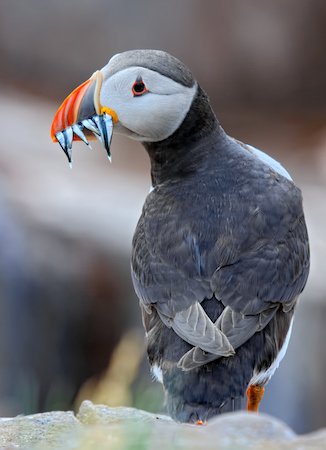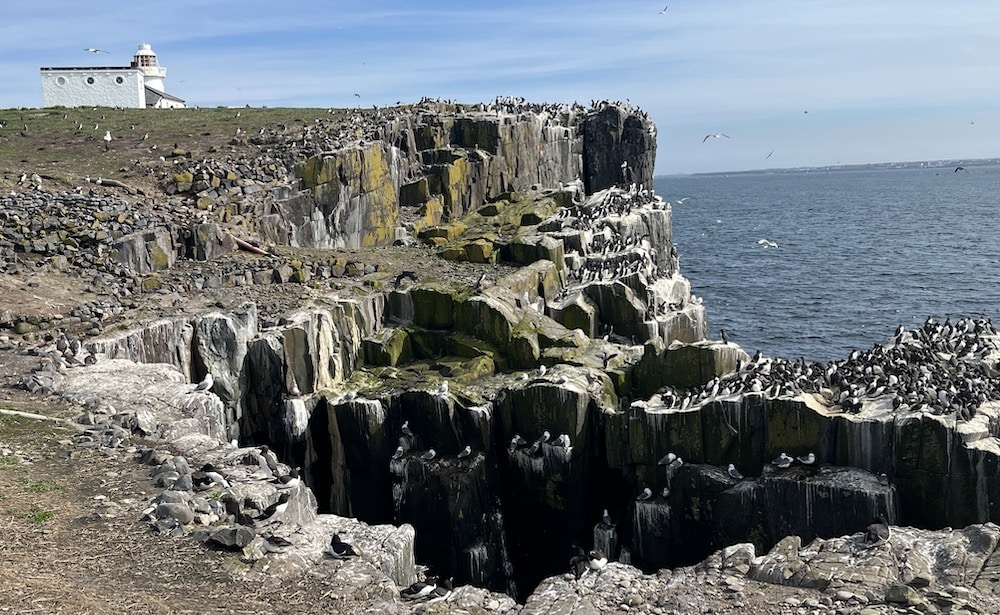Farne Islands

Birding The Farne Islands
The Farne Islands are a group of islands off the coast of Northumberland, England. There are between 15 and 20 islands depending on the state of the tide. They are scattered about 1.5 to 4.75 miles from the mainland and are divided into the Inner Group and the Outer Group. The main islands in the Inner Group are Inner Farne, Knoxes Reef and the East and West Wideopens (all joined together at a very low tide) and (somewhat separated) the Megstone; the main islands in the Outer Group are Staple Island, the Brownsman, North and South Wamses, Big Harcar and the Longstone. The two groups are separated by Staple Sound. The highest point, on Inner Farne, is just 62 feet above sea level.This uninhabited group of rocky islets were declared Britain’s first Nature Reserve by St Cuthbert in the 7th century. They remain under the protection of the National Trust.
In the warmer months this important wildlife habitat, is much-visited by boat trips from Seahouses, which are licensed to land passengers on Inner Farne, Staple Island and the Longstone; landing on other islands is prohibited to protect the wildlife. At the right time of year, many puffins can be seen and these are very popular with visitors; on the Inner Farne, the Arctic terns nest close to the path and will attack visitors who come too close (visitors are strongly advised to wear hats). Some of the islands also support a population of rabbits, which were introduced as a source of meat and have since gone wild. The rabbit and puffin populations use the same burrows at different times, the puffins being strong enough (with a vicious bite) to evict the rabbits from the burrows during the nesting season. The islands also hold a notable colony of about 6,000 grey seals, with several hundred pups born every year in September–November.

Spring on the Farne Islands ©Chris Lotz
Little can prepare the birder, who may have hung precariously over cliff edges to photograph Britain’s auks, for the landing on Staple Island. Here you find yourself surrounded by Guillemots, Puffins, Kittiwakes and Shag and they don’t take flight as you all but brush past them.
There are no rare birds here but the visitor can approach the birds so closely, and they are present in such concentrations, that a visit to these Isles will remain an unforgettable experience. For intimate bird photography the islands are incomparable in Britain.
Landing on Inner Farne is a different experience, here thousands of terns: Arctic, Common, Sandwich and Roseate nest. And some nest right next to the boardwalk. These elegant birds expend a great deal of energy mobbing everyone who walks past them. On sunny days you are dive-bombed from out of the sun which makes photography something of a challenge; this cannot be said of the birds of Staple Island. The auks and other seabirds can also be seen here, but it is the terns one comes to see.
Visiting – Currently there are half day trips to Staple Island from Seahouses in the mornings and to Inner Farne in the afternoon. Both trips tour the other islands and allow a close approach to the Grey Seals. These trips give you an hour ashore.There are whole day trips on which both islands are visited – these are crowded with about 60 folk per boat compared to the dozen or so on the half day excursions. There are also non-landing visits to the island group.
-
Tim Dean
2 Knocklaw Park, Rothbury, Northumberland NE65 7PW
01669 621460
-
Wildlife of the Farne Islands: A Guide to All the Major Breeding Species
| By Kaleel Zibe | Kaleel Zibe Photography | 2011 | Paperback | 160 pages, colour & b/w photos | ISBN: 9780956929600 Buy this book from NHBS.com
-
Farne Islands
WebpageLots of infor for visiting
-
Farne Islands IBA
WebpageSatellite ViewA group of islands and rock stacks lying between 2 km and 6 km off the Northumberland coast at Bamburgh. Vegetation is limited to pioneer species due to the maritime conditions and the impact of large numbers of seabirds…
-
Billy Shiel's Boat Trips
Boat TripsThe Farne Islands lie two to three miles off the Northumberland coast midway between the fishing village of Seahouses and the magnificent Castle of Bamburgh. There are between 15 and 20 islands depending on the state of the tide. From April until the end of July, these islands are dominated by one of the most exciting seabird colonies in the United Kingdom with unrivalled views of 23 species, including around 43,000 pairs of puffins. Truly, the sight of such numbers in the natural and wild habitat of the Farne Islands is a beauty and joy to behold. The islands are also the permanent home for a large, and inquisitive colony of Atlantic or Grey Seals. This is one of the top grey seal pupping sites in England, with more than 2000 pups born out at the islands every Autumn/Winter. -
Serenity Farne Island Boat Tours
Boat TripsA variety of flexible trips to and around the islands. Andrew Douglas is a passionate birder and photographer, who often goes the extra mile (often literally!) to show guests spectacular sightings....
-
Springhill Farm Holiday Accommodation - Seahouses
AccommodationSpringhill Farm is situated within miles of beautiful countryside, and is a haven to some of the most breathtaking beaches on the Northumberland Heritage Coastline. With the nearby fishing village of Seahouses providing a perfect gateway to the Fame Islands nature reserve…

